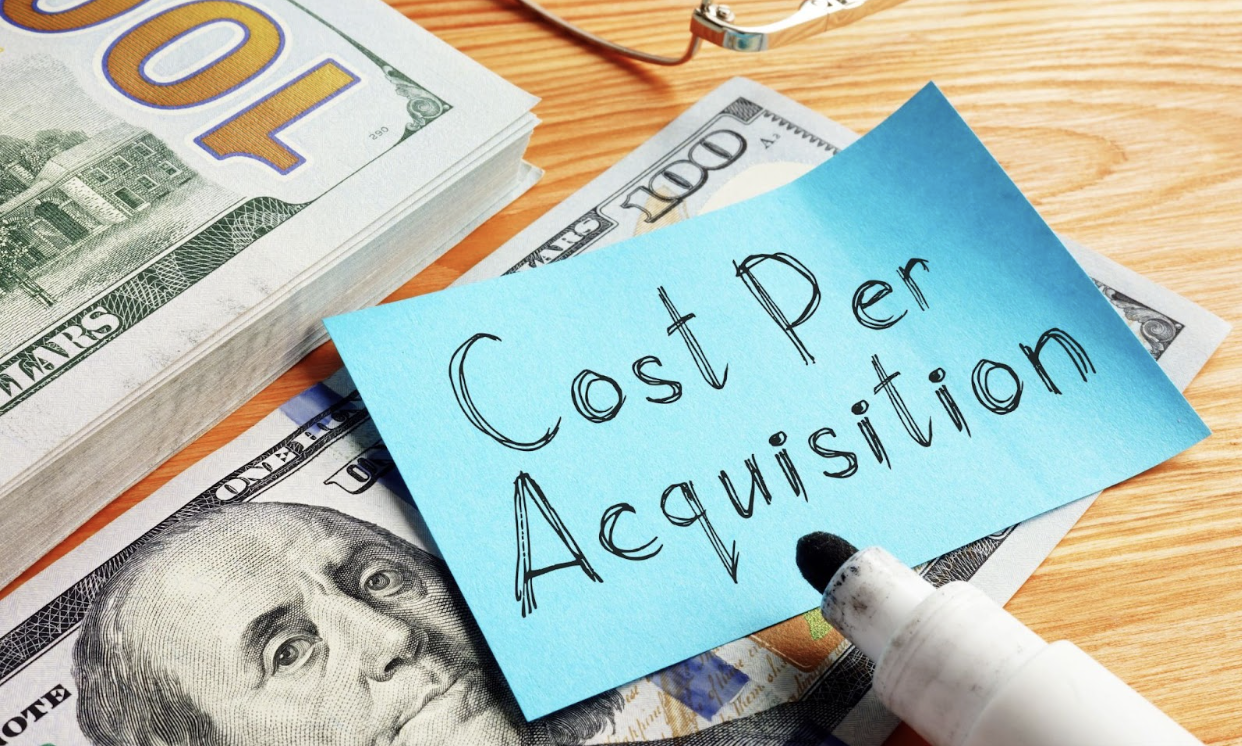CPA Calculation for Beginners: Step-By-Step Tutorial

Navigating the world of digital marketing can feel overwhelming, especially when diving into metrics like cost per acquisition (CPA). In this beginner's guide, we'll explore the meaning and significance of CPA, the key factors influencing it, and practical calculation methods. By the end, you'll understand CPA basics and learn strategies to improve your marketing efforts while effectively managing costs.
What Is Cost Per Acquisition?
 Cost per acquisition is a marketing metric that calculates the total expense of acquiring a new customer via a particular channel or campaign. With CPA, brands pay for each new acquisition resulting from their ad campaigns, such as sales or form submissions. Calculating CPA accurately is important because it helps determine if your marketing is paying off and lets you adjust your strategies wisely. So, by getting your CPA right, you can make smarter decisions about where to put your advertising money and how to get the most out of it.
Cost per acquisition is a marketing metric that calculates the total expense of acquiring a new customer via a particular channel or campaign. With CPA, brands pay for each new acquisition resulting from their ad campaigns, such as sales or form submissions. Calculating CPA accurately is important because it helps determine if your marketing is paying off and lets you adjust your strategies wisely. So, by getting your CPA right, you can make smarter decisions about where to put your advertising money and how to get the most out of it.
What key factors affect cost per acquisition?
Many factors affect your cost per acquisition. One is your choice of marketing channel, as each channel—such as affiliate marketing, pay-per-click (PPC) marketing, and content marketing—has its own costs and conversion rates. Competition and demand can drive costs, while targeted ads and well-designed landing pages can boost conversions. Lastly, budget matters. Larger budgets may broaden reach but can increase CPA if not optimized effectively.
How to Calculate CPA for Beginners
Calculating cost per acquisition is essential, as it allows you to figure out how much you're spending to acquire each new customer and assess the performance of your marketing efforts. To calculate CPA, simply divide your ad campaign's total cost by the number of acquisitions generated. Let's delve deeper below.
1. Find Your Total Ad Spend
To calculate your CPA, you must first know how much you spent on advertising during a specific period, including costs for:
- Pay-per-click (PPC) ads, like Google Ads and Bing Ads
- Social media ads, like Facebook Ads and Instagram Ads
- Display ads
- Any other marketing expenses aimed at getting new customers
Gather data from your ad accounts, invoices, and financial records, then add up all the costs related to your marketing campaigns for the period you want to analyze.
2. Count Your Conversions
A conversion is when someone takes your desired action, like making a purchase or signing up for your service. To calculate CPA, you need to know how many conversions your ads generated. Set up conversion tracking in your ad platforms, like Google Ads or Facebook Ads Manager, and website analytics tools. Clearly define what counts as a conversion for your business goals.
3. Use the CPA Formula
The CPA formula is simple: CPA = Total Ad Costs / Number of Conversions For example, if you spent $5,000 on ads and got 100 new customers, your CPA would be: CPA = $5,000 / 100 = $50 This means that during that period, you spent an average of $50 to acquire each new customer through your marketing efforts.  So, your cost per acquisition for that period was $50 per new customer.
So, your cost per acquisition for that period was $50 per new customer.
Understanding CPA Results
Setting Realistic Goals
It's crucial to set realistic CPA goals for your marketing campaigns. While industry averages are a helpful benchmark, your goals should match your business objectives, profit margins, and a customer's lifetime value. A rule of thumb is to aim for a CPA that's less than the expected lifetime value of a customer, ensuring your campaigns are profitable in the long run.
Optimizing Campaigns
Regularly monitoring and analyzing your CPA data can help you identify areas for improvement and optimize your campaigns. These optimizations could include:
- A/B Testing: Experiment with different ads, targeting, and landing pages to find the best-performing variations.
- Refine Targeting: Use data insights to refine your audience targeting and focus on high-converting segments.
- Adjust Budgets: Reallocate budgets towards top-performing channels and campaigns with lower CPAs.
- Improve Quality Scores: Enhance ad relevance, click-through rates, and landing page experiences to reduce costs.
- Leverage Automation: Use automated bidding strategies and machine learning to optimize bids and targeting for better CPAs.
Remember, optimizing CPA is an ongoing process. Monitor your data regularly, test new strategies, and adjust your campaigns to get the most out of your marketing. Additionally, consider utilizing giveaways and contests as part of your marketing mix. These tactics can attract a larger audience, generate more leads, and ultimately lead to more conversions. Platforms like Raffle Leader lets you easily create beautiful giveaways, contests, and sweepstakes, and customize them to suit your needs.
Continuing CPA Learning
Mastering CPA calculation is an ongoing process as marketing strategies and customer behavior evolve. To refine your CPA analysis and optimization efforts, consider the following:
- Industry reports and benchmarks: Stay updated on CPA trends in your sector.
- Case studies and success stories: Learn from the experiences of marketing experts.
- Online courses and certifications: Enhance your CPA and marketing analytics skills.
- Webinars and conferences: Explore data-driven marketing strategies.
Continuously learning and staying updated on CPA best practices will help you make informed decisions, maximize your marketing return on investment (ROI), and drive sustainable business growth.
Common Mistakes in CPA Calculation
Understanding cost per acquisition is essential for managing marketing campaigns effectively and optimizing budgets. Several common errors can result in inaccurate CPA calculations, negatively affecting decision-making. Here are some pitfalls to avoid:
Not Tracking All Ad Spend
One of the most common errors is failing to account for all advertising expenses. Many marketers only consider the direct costs of a specific campaign, such as ad spend on a particular platform. However, it's essential to include all related expenses, including:
- Agency fees
- Creative development costs
- Any other overhead expenses directly tied to the campaign
Overlooking these additional costs can lead to an underestimated CPA, poor budget allocation, and unrealistic expectations.
Including Non-Advertising Costs
While it's crucial to account for all advertising expenses, some marketers make the mistake of including non-advertising costs in their CPA calculations. These costs may include:
- Salaries
- Office rent
- Software subscriptions
- Other general marketing expenses not directly tied to a specific campaign
Including these unrelated costs can inflate the CPA and distort the actual performance of your marketing efforts.
Ignoring External Factors
External factors, like seasonality, market trends, and economic conditions, can significantly impact your CPA. For example, during peak seasons or periods of high demand, costs may increase due to high levels of competition and consumer activity.Failing to account for these external factors can lead to inaccurate CPA calculations and unrealistic expectations. It's important to monitor and adjust your CPA calculations based on external factors and consider historical data and industry benchmarks to set realistic CPA targets.
Conclusion
 Cost per acquisition measures how much you spend to acquire a new customer. Calculating CPA correctly is vital for managing marketing budgets and campaigns. To find your cost per acquisition, first add up all your advertising expenses like agency feeds, creative work, and overhead. Then, figure out how many conversions you've had using tracking tools and decide what counts as an acquisition based on what you're aiming for in your business. Finally, divide the total advertising costs by the number of conversions. By following a basic formula, you can easily calculate your CPA and make data-driven decisions to optimize your marketing efforts.
Cost per acquisition measures how much you spend to acquire a new customer. Calculating CPA correctly is vital for managing marketing budgets and campaigns. To find your cost per acquisition, first add up all your advertising expenses like agency feeds, creative work, and overhead. Then, figure out how many conversions you've had using tracking tools and decide what counts as an acquisition based on what you're aiming for in your business. Finally, divide the total advertising costs by the number of conversions. By following a basic formula, you can easily calculate your CPA and make data-driven decisions to optimize your marketing efforts.

